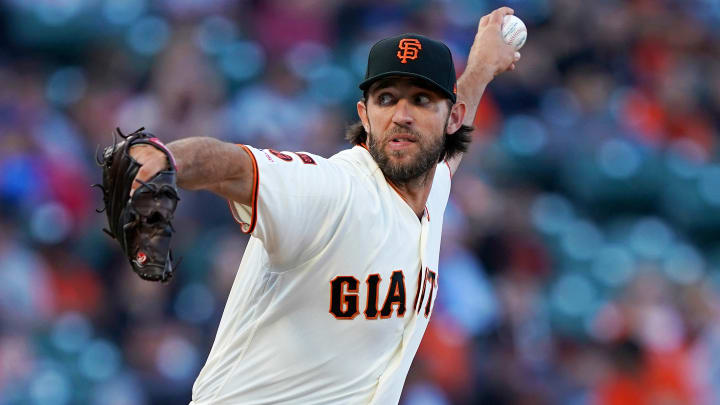Why Wasn't Madison Bumgarner Traded? Look to the Contenders for Answers

PHILADELPHIA — Four p.m. Eastern had come and gone, a clubhouse attendant was clearing out a neighboring locker and still Giants lefthander Madison Bumgarner’s cubicle sat untouched. Same tin of Copenhagen snuff. Same glove, with MB stitched into the leather. Same two road SAN FRANCISCO jerseys.
Same risk-averse league.
No one ever actually told Bumgarner that the Giants had elected not to deal him, he said a few minutes later, but once the trade deadline passed, he assumed he was sticking around. In fact, he insisted, he was so unworried that he didn’t even notice when the clock struck 4. He was in the weight room; someone else announced the time. (“I don’t believe that,” says his longest-tenured teammate, catcher Buster Posey.)
If Bumgarner had paid closer attention, he might have realized as early as Sunday that he was sticking around. That’s when the Blue Jays traded a 28-year-old ace for a pair of pitching prospects not ranked among the top 100 in the game. Bumgarner has been worth more over his career (35.8 WAR) than Marcus Stroman (13.6), but the Mets will have Stroman through 2020. Bumgarner, who turns 30 on Aug. 1, will be a free agent in November. If that’s the best Toronto could do, why would San Francisco president of baseball operations Farhan Zaidi part with a franchise icon?
Third baseman Evan Longoria, who spent 10 years starring for the Rays before they dealt him to San Francisco before last season, knows a little something about trading away franchise icons. The Giants are struggling to stay above .500 and unlikely to make a real run this year. Even Longoria thought the lefty was gone.
“It was probably like 60–40 in my eyes,” he says. “Sixty percent thought he was gonna get traded, just because of some of the things Farhan has said since the beginning of the year. I just thought he might get the opportunity to rebuild the farm system.” He speculates that perhaps Zaidi retained Bumgarner either because the team intends to re-sign him or “simply out of respect for Madison, giving him and [longtime manager Bruce Bochy, who has said he will retire after this season] and us another opportunity to go out there and do something special.”
There is one other possibility, the most logical of them all: If the Giants extend Bumgarner a qualifying offer this offseason and he signs elsewhere, his old team nets a first-round draft pick. Zaidi declined to discuss trades he did not make, but it stands to reason that if someone had offered him something more valuable than a first-round draft pick, he would have taken it.
Bumgarner means more to the Giants than to any other organization. Elsewhere, he would be a mercenary. In San Francisco, he is the legend who helped bring the city its first title, then added two more. He is the superhero who threw seven one-run innings in Game 1, a shutout in Game 5 and five scoreless innings to clinch Game 7. He is the all-time great whose face is on posters in countless bedrooms.
Zaidi did not watch any of this history from up close. He arrived before this season began, after four years with the Dodgers. He was charged with rebuilding a team that has not won a postseason series since Bumgarner closed out that 2014 World Series. Zaidi could probably not have made a deal for Bumgarner that only marginally improved his roster. The fanbase, the ownership and the clubhouse would all have revolted. The proposal needed to be strong. But Bumgarner has a limited no-trade clause that allows him to block deals to the Braves, Red Sox, Cubs, Astros, Brewers, Yankees, Phillies and Cardinals. Zaidi never got far enough in negotiations to ask Bumgarner to waive it.
What an indictment of the league. Baseball-Reference gives the Yankees a 98.6% chance of making the playoffs. It also ranks New York’s starting pitching No. 26 in the game. The Braves have a 97.2% shot and the 25th-best rotation. The Cardinals, 57.3% and No. 23. The Red Sox, 30.2% and No. 14. The Diamondbacks have a 35.3% chance and the 13th-best rotation, but they just traded their No. 1, righty Zack Greinke, to the Astros.
Houston has a 99.9% chance to make the playoffs and the second-best rotation in the game. On Wednesday, it added Greinke and Blue Jays righty Aaron Sanchez. The Astros won the World Series in 2017. They seem to be the only contender with much interest in doing that again.
New York did nothing of note at the deadline. Boston did nothing at all. Atlanta, at least, picked up two late-innings relievers. St. Louis added a reliever.
“I felt comfortable walking away,” Yankees GM Brian Cashman said after coming up empty.
“I’m not disappointed,” said Red Sox president of baseball operations Dave Dombrowski.
Cardinals president of baseball operations John Mozeliak did acknowledge a “high level of frustration,” but said in the end the price to upgrade was too high.
Too high for Madison Bumgarner? Too high to reshape your October rotation, to materially improve your chance at a championship?
The Yankees won their game today, by the way. But their starting pitcher, Masahiro Tanaka, only lasted four innings.
